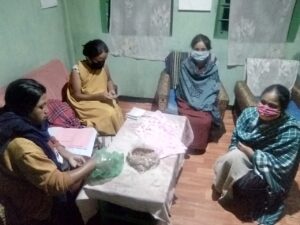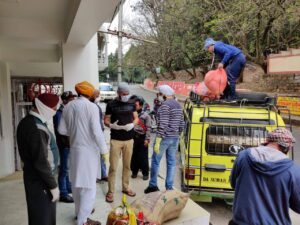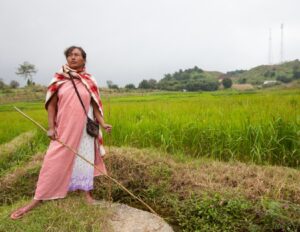Written by Jason Iangrai
Human societies have progressed from hunter-gatherers to pastoralists and gradually industrialists before easing into the current age of information and communication technology. However, throughout this evolution period, there are still communities that rely on traditional practices such as foraging to meet their needs.
According to the United Nations, of the 8.2 billion people globally, over 476 million belong to indigenous communities, all sharing a special relationship with nature. Among them is the Khasi community in Meghalaya, India. Though many Khasis have embraced Christianity, the community as a whole remains deeply rooted in their ancestral connection with nature—a connection so deep it permeates every aspect of life. For us Khasis, nature is not just a resource for survival but a sacred entity that embodies cultural, spiritual, and communal identity. To this day, the belief holds that disrespecting nature is akin to dishonouring the divine. As a result, there is a continued reverence and protection of forests. The sacred groves of Mawphlang best exemplify this, where ancient forests are preserved, safeguarding both the natural environment and our cultural legacy.
As the saying goes, “India lives in its villages,” and this is especially true in rural areas of Meghalaya, where traditional wisdom thrives alongside a deep regard for nature. These villages in North East India act as custodians of indigenous knowledge, as they continue to rely on nature for their resources. This knowledge possessed by them is not merely traditional but a dynamic understanding of ecosystems, medicinal herbs, farming, and sustainability. In Khweng village, Eri silk is produced through an eco-friendly process. To promote sustainability, locally sourced fruits and flowers like Soh Lyngdhkur (Mulberry), Sohiong (Khasi cherry), and Tiew Jaiñ (Hibiscus) are used to dye the fabric, balancing ecology and cultural practices.
It is also quite likely that the intricate and holistic relationship that our ancestors shared with nature led them to discover wild edibles for consumption, and in the quest to find out more, I had made my way to Umsawwar village (Mawkynrew C&RD block), a strong partner community of NESFAS. While I was there, I had an interesting encounter with Kong Angela Nongrum, a traditional knowledge holder. She explained that in the past, before people had knowledge of cultivation, they would move from place to place, constructing temporary shelters in forests while foraging for wild foods and hunting animals. They closely observed the types of wild plants consumed by animals to determine their edibility. Similarly, they would watch where birds gathered to feed on fruits, patiently observing the behaviour of birds and animals to assess whether the food was safe for human consumption.
Furthermore, when it came to medicinal herbs and plants, they looked for the types of edibles that domesticated animals instinctively consumed when they were ill.
Back in the day, communities consumed wild edibles mixed with rice, and as a result, the prefix ja (rice) was applied to them. They would shred wild edibles like jarain, jamyrdoh, and jali and combine them with rice to make a more filling meal and would also consume the wild edibles raw. Because of this, they continue to use the term ja to this day, like in the cases of ja dai (Khichdi) and ja doh (meat with rice).
This shared understanding with nature echoed in another conversation I had, this time with Babu Nestar Kharmawphlang at the recently held Mei-Ramew Farmer’s Market at NESFAS’ office. He is a school teacher and farmer from Laitsohpliah village, and I was fascinated by his insightful wisdom into our culture. We sat down and talked about his lived experiences, and he painted a vibrant picture of his time in the 70’s, where he spent his days by the river Umiam to accompany his father while farming. He told me that they would cook millet and mix it with Pashor kait (plantain flower) to make a hearty dish.
Moreover, he personally believes that our ancestors possessed immense knowledge and understanding of Mei-Mariang (mother nature) as a result of their close proximity with it and also recalled bits and parts of a folktale narrated by Kong Twian Nongrum, an elderly knowledge holder who also happens to be his neighbour. She had told him that in the olden days, when people chose to reside in forests and rice or millet was a rare commodity, women who had just given birth could survive on pashor kait alone for a day or two.
This transmission of oral traditions, passed down from one generation to another, is nothing new to us, and it ensures the preservation of cultural beliefs and practices that might otherwise be lost.
However, despite this deep connection to our past, Khasi traditions are increasingly threatened by modern challenges. Despite being nutritionally rich, climate-resilient, and sustainable, our traditional food systems are threatened by the lack of cultural promotion and policy support. The National Food Security Act (NFSA) of 2013, intended to combat hunger and food insecurity, focuses predominantly on commodities like rice and wheat, overlooking the nutritional diversity offered by traditional food systems. Indigenous varieties, such as fruits, vegetables, and pulses, and even starchy staples, are known to provide higher levels of micronutrients; policy emphasis on high-yield varieties undermines their importance.
Moreover, farmers in Meghalaya face significant challenges in accessing markets, as government procurement systems predominantly favour commercial crops. As of June 2024, our state has also recorded one of the highest rates of the Consumer Price Index (CPI) ever, with an increase of 1.77 percent as compared to the month before that, indicating inflationary pressure on essential goods and services within the state. This is largely due to geographical challenges and administrative barriers: hilly terrain, high transportation costs, unchecked toll gates, and a lack of price regulation. As a result, we often hear residents say that the prices of essential commodities differ between Meghalaya and neighbouring states.
Even at the policy level, rather than leveraging on indigenous food as a cultural asset by incorporating it into state festivals and tourism campaigns, our policymakers have chosen the other route. We have all seen how the government organised the Strawberry Festival in multiple districts earlier this year; this choice reflects a broader issue where local and nutrient-dense foods are overlooked for commercial products.
By promoting more native fruits, the state could have not only preserved cultural heritage but also revitalised traditional knowledge and practices, all while boosting the local economy. The strong bond that exists between humans and the land could be reinforced by such an approach, which would also strengthen community resilience and improve nutrition.
Despite the immense value, it is undeniable that indigenous food systems are often neglected, especially in science and policy. This lack of recognition is concerning, especially considering the fact that these systems are not merely about food; they represent centuries of accumulated wisdom, practices, and traditions. These systems have also sustained our ancestors for generations and serve as a living link to our heritage. The wisdom passed down through generations is not something to be left in the past; it is a treasure waiting to be embraced, reshaped, and revitalised in our evolving world. As such, if they are not protected, we run the risk of losing both our valuable biodiversity and, most importantly, our cultural identity.



